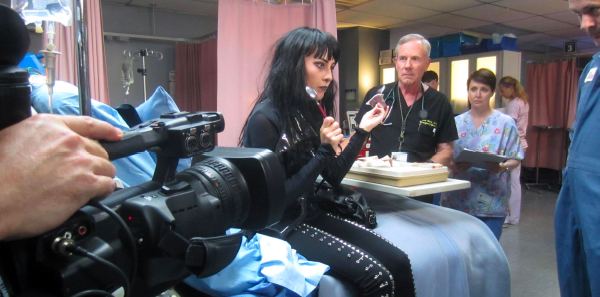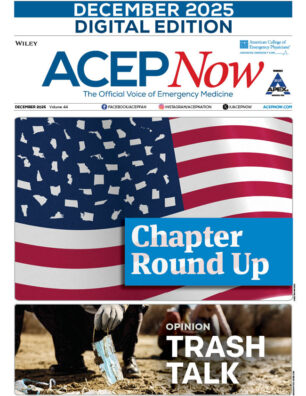
Emergency medicine pioneer Robert Slay, MD, recently discussed his emergency medicine career and his acting with ACEP Now.
Explore This Issue
ACEP Now: Vol 39 – No 07 – July 2020ACEP Now: How did you get your start in emergency medicine?
RS: After completing an Army residency in internal medicine, I passed the internal medicine board exam but functioned as an internist for only one year. In 1976, I was assigned to Brooke Army Medical Center in San Antonio, Texas, as an internist. Brooke had more than 700 beds and an ER that was a major trauma center and saw around 60,000 patients a year. There was no recognized EM specialty and just the beginning of a few fledgling training programs in emergency medicine nationwide.
The chief of internal medicine at Brooke gave me an alternative to being exiled to the eternally boring abyss of the clinic. “Bob, we have a real problem with our medicine residents running amok in the ER with no supervision—they are killing patients,” he said. “Would you be willing to go down there and stop the carnage and maybe even teach them?”
I snapped up the offer. I and several other atypical internists began supervising while learning emergency medicine, with the residents rotating in the ER. Two years later, we got approval and started the first EM residency training program in the armed forces.
I was able to grandfather in to taking and passing the newly established EM board exam. I finished a 20-year Army career as a colonel, residency director, and chief of the department of emergency medicine at Brooke.
While assigned at Brooke, I had the privilege of becoming a member of the elite antiterrorist, super-secret Delta Force. I participated in the ill-fated hostage rescue attempt in Iran in 1980. The debacle of Desert One and failure of the hostage rescue mission haunt me to this day.
After retiring from the Army, I have worked in emergency medicine as an emergency physician and continue to work in a community hospital in San Pedro, California. I also had the good fortune to become an oral board examiner for the American Board of Emergency Medicine.
ACEP Now: How did you become involved with the TV show Untold Stories of the ER?
RS: I was working in the Los Angeles area in 2005 and had gained some notoriety as an EM storyteller. I have always liked to perform, and I found that stand-up comedy is fun but a real challenge and requires lots of practice. I did better just telling real ED stories. As all emergency physicians know, there are some real stories we tell each other that are not just unbelievable but often funny.
During the first year of the show, one of the show’s producers had seen me perform in a storytelling contest and contacted me to do the show. I had a funny story of moonlighting in an ED in a small Texas town and dealing with a pseudo coma patient, a local football hero, a crusty old ED nurse, and an old-school local doc who taught me how to really practice medicine. The story was called “Coma Cowboy.” It is still one of the most popular stories of the series to date.
Since then, I have been lucky enough to write for and act in 16 shows over 14 seasons. I continue to perform, both as a storyteller and in stand-up. My YouTube channel is “Dr. Bob Slay, ER Story Teller.” When you see my performances, you will understand why I keep my day job.
ACEP Now: Why should emergency physicians consider doing the show?
RS: I know all emergency physicians out there have a story. It should be told. The producers want drama, humor, truth, and a formula. The story should include a mystery diagnosis, an “aha” moment, and a great conclusion.
An example is a story I did with a pediatric patient with a suspicious long bone fracture and a positive total body X-ray for multiple fractures. Child protective services were called for obvious child abuse, and the child was taken from the parents. The “aha” moment was noticing the child’s blue sclera and confirming an osteogenesis imperfecta diagnosis. The parents were absolved, and we concluded with a tearful, warm, and fuzzy ending.
Do it for your legacy. We are all toiling away in the ED, seeing incredible human suffering, salvation, and hope. We need to tell the world. Do your kids know what you really do? Do the show, and you can show them, your grandkids, and the world.
ACEP Now: Do patients recognize you from the show?
RS: Yes, about every other shift. They recognize my voice and ask me if I am on the show. Usually, it is a young girl around age 9 because almost 80 percent of the viewers are female and between the ages of 7 and 32 years old. I take a lot of selfies with 11-year-old girls.
ACEP Now: How can emergency physicians become part of the show?
RS: I assume the show is going to have a 15th season because it is the longest-running reality-based medical show in television history. I will be submitting my ideas, and I hope other emergency physicians will as well. Send show ideas to the producer, Bob Niemack, at
bniemack@mac.com. Bob will get back to you—he loves a good story.
Take a risk and send a story idea. These stories need to be told. You know you can act; you have been acting your entire career!
Pages: 1 2 3 | Multi-Page

 If your idea for an Untold Stories show is accepted, you will be offered the opportunity to tell your story on camera and to reenact it as yourself. Amateur-actor doctors playing themselves—every director’s nightmare. Untold Stories is a scripted, reality-based show, so the doctor-actor must recite dialogue, hit their marks, and perform procedures, all with cameras and lights in their face and 30-odd people (the crew) watching.
If your idea for an Untold Stories show is accepted, you will be offered the opportunity to tell your story on camera and to reenact it as yourself. Amateur-actor doctors playing themselves—every director’s nightmare. Untold Stories is a scripted, reality-based show, so the doctor-actor must recite dialogue, hit their marks, and perform procedures, all with cameras and lights in their face and 30-odd people (the crew) watching.
5 Responses to “Q&A with a Real-life Doc from the TV Series Untold Stories of the ER”
July 27, 2020
Ros McIntoshFascinating story, Bob!!!
Congratulations!
I’m very impressed and shall try to find it; is it on radio or Tv? Do want to hear you.
All best to you and Gayne. I just returned from Sun Valley, spending four months with Mimi and taking daily walks with Alison,
Ros
rosimcintosh1@gmail.com
April 18, 2021
John PapadakisBob Slay is tops in the ER
He is glue for the Soul
and, he is a clearing house on the Tennis Courts
John Papadakis
RANCHO PALOS VERDES CA
November 18, 2024
Kay AgnewI love the show and you are my favorite doctor on the show! Who’s Gayne?
December 26, 2024
Kurstyn BeagleI wish a Dr. Could solve my intestinal issues it’s been 8 years of sickness. Love the show.
September 22, 2025
LeslieI think you’re wonderful and I am really sorry the show isn’t active anymore. I would welcome any return by you to television. Miss you!